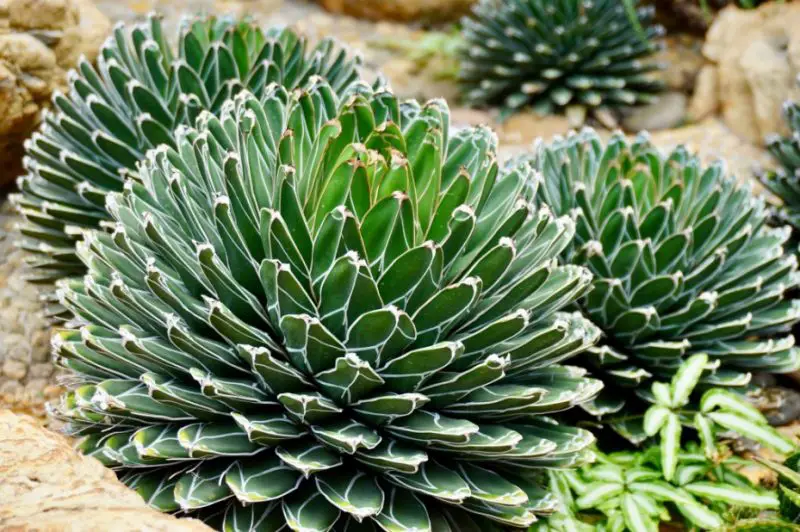Queen Victoria Agave (Agave victoriae-reginae) is a stunning succulent prized for its compact form and striking appearance. Native to the arid regions of northern Mexico, this slow-growing species has become a favorite among gardeners and collectors due to its architectural beauty and adaptability to various conditions.
In this guide, we will provide a comprehensive look at how to care for and cultivate Queen Victoria Agave, ensuring it thrives in your garden or container.
What is Queen Victoria Agave?

Queen Victoria Agave, named after Queen Victoria of England, is one of the most exquisite agave species. It is characterized by its symmetrical rosette of thick, triangular leaves, each marked with distinctive white margins and edges. The plant remains relatively small, typically growing to 12-18 inches in height and width, making it ideal for small gardens and container arrangements.
Key Features of Queen Victoria Agave
The key feature of Queen Victoria Agave is its compact, globe-like rosette of dark green leaves with fine, white lines creating a unique geometric pattern. The plant’s terminal spines are less pronounced compared to other agave species, adding to its appeal for gardeners looking for less spiny options.
This species is also monocarpic, producing a spectacular flowering stalk up to 15 feet tall late in its life. After flowering, the plant dies, but it often produces offsets or seeds to continue its lineage. Its slow growth and drought tolerance make it a favorite in xeriscaping and low-maintenance landscapes.
How to Grow Queen Victoria Agave
Selecting the Right Location
Queen Victoria Agave thrives in sunny environments. Choose a location that receives at least 6 hours of direct sunlight daily. While it can adapt to partial shade, prolonged lack of sunlight may lead to weaker growth and diminished leaf coloration.
Ensure good air circulation to minimize humidity buildup, which can lead to fungal issues. This plant is particularly well-suited for USDA hardiness zones 7-11, thriving in hot, arid conditions.
Soil Requirements
The right soil is essential for the health of Queen Victoria Agave. It prefers well-draining soil, such as sandy or rocky substrates. If planting in containers, use a cactus or succulent mix to prevent water retention.
In gardens with heavy clay soil, amend the planting area with coarse sand or gravel to improve drainage. Avoid waterlogged areas, as this can cause root rot.
Temperature and Climate
Queen Victoria Agave is highly tolerant of heat and drought but is less hardy in freezing temperatures. It can withstand occasional light frost but should be protected when temperatures drop below 20°F. In colder climates, growing the plant in containers allows for easy relocation during winter.
Planting Queen Victoria Agave
When to Plant
The best time to plant Queen Victoria Agave is during the spring or early summer. This allows the plant to establish roots in warm soil before the onset of colder weather.
How to Plant
- Choose a location with well-draining soil and ample sunlight.
- Dig a hole twice as wide as the plant’s root ball and slightly deeper.
- Carefully remove the plant from its container and loosen the roots gently.
- Place the agave in the hole, ensuring the base of the rosette is level with the soil surface.
- Backfill with amended soil, pressing gently to eliminate air pockets.
- Water lightly to settle the soil without over-saturating.
Caring for Queen Victoria Agave
Watering Requirements
Queen Victoria Agave is drought-tolerant and requires minimal watering once established. During the first few months after planting, water weekly to help the roots establish. Once established, reduce watering to once every 2-4 weeks, depending on the season.
In winter, the plant enters dormancy and requires very little water. Always ensure the soil dries out completely between watering sessions to prevent root rot.
Fertilizing Queen Victoria Agave
While not a heavy feeder, occasional fertilization can support healthy growth. Apply a balanced, water-soluble fertilizer diluted to half strength during the growing season (spring and summer). Avoid over-fertilizing, as this can encourage excessive growth, weakening the plant’s natural form.
Do not fertilize during fall and winter when the plant is dormant.
Pruning and Maintenance
Pruning for Queen Victoria Agave is minimal. Remove dead or damaged leaves as needed to maintain its aesthetic appeal and prevent pest infestations.
When handling the plant, wear gloves to protect your hands from the terminal spines. If the plant produces offsets, they can be removed during maintenance for propagation.
Pests and Diseases
Queen Victoria Agave is relatively pest-resistant but may occasionally encounter issues such as:
- Agave Snout Weevil: This pest burrows into the plant’s base, causing collapse. Inspect regularly and remove infected plants promptly.
- Mealybugs: These pests can be treated with insecticidal soap or neem oil.
- Fungal Diseases: Overwatering and poor drainage can lead to root rot and fungal infections. Ensure proper soil conditions and watering practices to prevent these issues.
Propagating Queen Victoria Agave
Propagation is typically done through offsets or seeds. Offsets are the easiest and most reliable method.
Steps for Propagating by Offsets
- Wait until the offset is at least one-third the size of the parent plant.
- Use a sharp, clean knife to separate the offset from the main plant.
- Allow the offset to dry for 1-2 days to form a callus over the cut area.
- Plant the offset in well-draining soil and water lightly.
- Place in a sunny location and monitor for new growth.
Landscaping with Queen Victoria Agave
Rock Gardens
The compact size and unique shape of Queen Victoria Agave make it an excellent addition to rock gardens. Its dark green leaves with white markings provide a striking contrast against stones and gravel.
Xeriscaping
Queen Victoria Agave is perfect for xeriscaping due to its drought tolerance. It pairs well with other succulents and cacti, creating a low-maintenance, water-efficient landscape.
Container Gardening
In colder regions or urban settings, Queen Victoria Agave thrives in containers. Choose a pot with excellent drainage and use a cactus soil mix. Move the container indoors during winter to protect the plant from frost.
Accent Plant
As a solitary specimen, Queen Victoria Agave serves as a striking focal point. Its symmetrical form adds architectural interest to both modern and traditional garden designs.
Common Issues with Queen Victoria Agave
Yellowing Leaves
Yellowing leaves are often a sign of overwatering or poor drainage. Check the soil and adjust watering practices as needed.
Rotting Base
A rotting base is usually caused by root rot, which results from excessive moisture. Ensure the plant is in well-draining soil and reduce watering frequency.
Stunted Growth
Stunted growth can result from insufficient sunlight, nutrient deficiencies, or pest issues. Verify that the plant receives adequate light and nutrients, and inspect for pests regularly.
Benefits of Queen Victoria Agave
Ornamental Value
The symmetrical rosette and unique white markings of Queen Victoria Agave make it a standout ornamental plant for gardens and containers. Its compact size fits well in small spaces while delivering a bold visual impact.
Low Maintenance
This agave requires minimal care, thriving in drought-prone areas and needing little intervention. Its resilience makes it an excellent choice for busy gardeners.
Environmental Benefits
Queen Victoria Agave contributes to sustainable gardening by reducing water usage. Its ability to thrive in arid conditions makes it an eco-friendly choice for xeriscaping.
Conclusion
Queen Victoria Agave is a remarkable plant that combines beauty, resilience, and low-maintenance care. Whether used as a focal point, part of a rock garden, or in a container, it adds elegance and structure to any setting. By following this guide, you can ensure your Queen Victoria Agave thrives, providing years of enjoyment and admiration.






